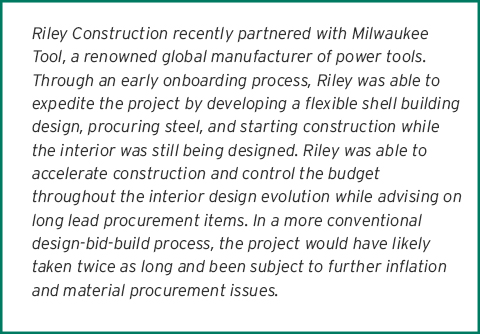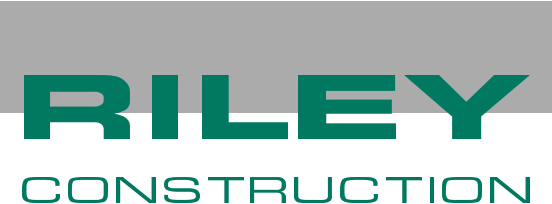It’s a time of challenge and opportunity for the construction industry. U.S. commercial construction spending is on track to increase by record levels in 2022. Simultaneously, this skyrocketing demand is combined with all-time material, labor, and equipment supply shortages.
In today’s volatile market, the firm price/hard bid project delivery comes with increased costs and project delay risks for owners. That’s why developing collaborative partnerships with subcontractors and designers is critical to avoiding these issues.
Here are four steps Riley Construction uses to keep projects on schedule and within budget.
Step 1: Set and control the budget
One of the top challenges faced during industrial projects is managing procurement and lead times to avoid cost overruns. Engaging the construction manager early in the planning process helps lay out design milestones that help owners understand when decisions need to be made. This provides the contractor with the necessary information to accurately budget and enables the owner to make financial decisions related to ordering long-lead materials.
Riley keeps the following factors in mind to ensure projects stay on budget throughout the planning and execution phases:
- Set priorities: Discuss with clients whether they value a project’s cost or timeline more, as both affect a project’s price and how procurement is handled.
- Identify long-lead items: Determine what requires early release and expedited procurement. Set funding schedules with owners.
- Establish benchmarks: During bidding, set material pricing by unit cost of product. Carry previous inflation allowances forward and leverage reliable industry metrics such as those from the Engineering News-Record (ENR) Indices to validate future price changes.
- Negotiate cost transparency: Make it clear to subcontractors and suppliers that everyone is getting a fair deal. If an owner is willing to share in the risk of material escalations, they are more likely to get a fair market price instead of an inflated number.
Step 2: Build strong relationships with contractors and suppliers
Here at Riley, trust is everything. Establishing a team of loyal contractors and suppliers allows for earlier engagement and results in an advisory team that helps control costs, steer the design, and limit clients’ exposure to changing lead-times and limited material availability.
 Riley uses a list of preferred local specialists and has several long-standing partnerships — many over 25 years — that provide key advantages for clients.
Riley uses a list of preferred local specialists and has several long-standing partnerships — many over 25 years — that provide key advantages for clients.
Here are just a few reasons why maintaining strong relationships is key:
- Earlier hold on scheduling slots during a time of limited availability of materials such as steel and precast.
- Ability to stay up to date on changing lead times and material availability as well as potential alternative materials or design options to solve for supply chain issues.
- Efficient teams that become well-versed in Riley’s planning and scheduling process.
- Better pricing from suppliers who value Riley’s on-time payments and efficiently run job sites.
Step 3: Prioritize upfront collaboration
Henry Ford once said, “If everyone is moving forward together, then success takes care of itself.” We see the truth in this philosophy as we use our design-assist process to gather the perspectives of subcontractors, architects, and industrial engineers — all with a common goal of achieving the best building for the owner in a timely and cost-efficient process.
![]() It’s also essential that every team member is in tune with and fully invested in the planning phase of the project. Riley’s proprietary InSTEP system incorporates Lean principles to define core priorities early on, customizing an approach for each project, maximizing productivity, reducing risk, and eliminating waste throughout the planning and scheduling processes.
It’s also essential that every team member is in tune with and fully invested in the planning phase of the project. Riley’s proprietary InSTEP system incorporates Lean principles to define core priorities early on, customizing an approach for each project, maximizing productivity, reducing risk, and eliminating waste throughout the planning and scheduling processes.
Engaging our mechanical, electrical, and plumbing engineers early on also simplifies the equipment purchasing process and helps minimize overall construction times by establishing a project team relationship at the outset.
Step 4: Pursue the latest technologies
Technology enables Riley to bring tangible benefits to all teams and projects. It also allows us to build faster and safer without surprises. We are always looking at ways to improve and modify designs to fit with the most accommodating materials available. From model-based estimating, which helps us develop accurate budgets, to laser scans that show realistic conditions of existing structures, we incorporate technology that provides value and efficiency.
Other construction technologies we leverage include:
- Prefabricated wall systems, bathrooms, mechanical, electrical, and plumbing components to save time and help mitigate potential labor shortages.
- 3D virtual project prototypes to help us work through design and coordination challenges before installation begins as well as support site logistics and scheduling.
- Riley runs cost comparisons of various technologies for budget and lead time considerations. For example, warehouse walls as IMP walls with steel perimeter vs. precast bearing walls.
Completing an industrial project on time and within budget means finding a team with strong relationships, depth of experience, and a commitment to collaboration and transparency. To learn more about how Riley can build a customized plan for your next project, contact project development manager Alex Egan at alexe@rileycon.com.

